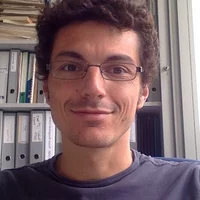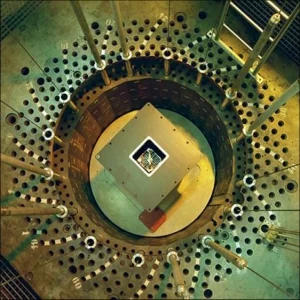PROTEUS is a zero-power nuclear research reactor that has been in operation from February 1968 to April 2011 at the Paul Scherrer Institute (PSI) in Switzerland. During the 20th century, it has been used to carry out experimental reactor physics investigations for a wide range of advanced reactor concepts, like the gas-cooled fast reactor (GCFR), the tight-pitch, high conversion light water reactor (HCLWR) and the modular high temperature reactor (HTR). In the 21st century PROTEUS has been mainly used to study modern and advanced light water reactor fuel for the Swiss nuclear utilities with the LWR-PROTEUS and LIFE@PROTEUS (Large-scale Irradiated Fuel Experiments) programmes.
In its ability to represent such different systems, the reactor can easily change its form - like PROTEUS, son of Poseidon, who was able to predict the future and also change his shape at will to escape being bothered constantly.
PSI decided for strategic reasons to shutdown the PROTEUS reactor in April 2011. As of today, the fuel has been unloaded from the reactor and the decommissioning is underway.
In its ability to represent such different systems, the reactor can easily change its form - like PROTEUS, son of Poseidon, who was able to predict the future and also change his shape at will to escape being bothered constantly.
PSI decided for strategic reasons to shutdown the PROTEUS reactor in April 2011. As of today, the fuel has been unloaded from the reactor and the decommissioning is underway.
Facts and Figures
PROTEUS is a zero-power reactor featuring a cylindrical central cavity that is driven critical by a surrounding graphite region fuelled with 5 wt% UO2 fuel pins. The central cavity (1.2m in diameter) can be filled with different sub-critical fuel arrangements (kinf as low as 0.7) and made critical to study different reactor concepts.
All the instrumentation and controls of the reactor are located in the graphite driver region not to perturb the central lattice to be investigated. The thermal power of the reactor is about 1kW, which amounts to a flux of about 5×109 n/s/cm2 in the graphite region. The reactor is cooled with natural air convection. Such low power allows to decoupled neutronics and thermal hydraulic effects and focus on the former by measuring, for example, reaction rate distributions.
All the instrumentation and controls of the reactor are located in the graphite driver region not to perturb the central lattice to be investigated. The thermal power of the reactor is about 1kW, which amounts to a flux of about 5×109 n/s/cm2 in the graphite region. The reactor is cooled with natural air convection. Such low power allows to decoupled neutronics and thermal hydraulic effects and focus on the former by measuring, for example, reaction rate distributions.
| Operation Dates | Feb. 1968 - Apr. 2011 |
|---|---|
| Thermal Power | 1 kilo Watt |
| Driver region dimensions | 3.5m diam./3.5m high |
| Central cavity dimensions | 1.2m diam./10m high |
| Central cavity fuel | Programme dependent |
Short History
During its history, the research programmes conducted at the PROTEUS facility have spanned a wide spectrum, and significant contributions have been made. PROTEUS is a driven system that can rather straightforwardly be adapted to model local core environments for a large number of different reactor concepts. Since February 1968, its versatility has enabled experimental studies of a rich diversity of different reactor concepts, such as the Gas-Cooled Fast Reactor (GCFR), the tight pitch High-Converting Light Water Reactor (HCLWR) and the modular High Temperature Reactor (HTR).
The earlier investigated advanced reactor types were of interest because they offered the possibility to use alternative fissile material and/or to breed new fissile material (thus increasing the fuel economy). Although the HTR offers a more efficient fuel usage too (due to a higher power conversion efficiency), the interest in this reactor concept mainly originated from the growing demand for an enhancement of the safety standards of nuclear power plants, which can be fulfilled by the inherent safety characteristics of the HTR. Inherent safety means that the core is designed in such a way that the guarantee for its integrity under any conceivable disturbed operational condition is based on the validity of physical laws rather than on the very low probability that multiple engineered safety mechanisms will fail.
Starting in mid 1996, work was underway to realise a new and exciting experimental programme addressing the second general research philosophy mentioned above. This first of its kind new programme was known as LWR-PROTEUS and marked a departure from the more exotic reactor concepts of the past to concentrate more upon the near- and mid-term needs of the LWR-community. The LWR-PROTEUS programme represented a conscious move from traditional critical experiments, in which specially prepared mock-up lattices are investigated, to a concept in which authentic power reactor fuel was first investigated in PROTEUS before use as normal reactor fuel in a power station. It was aimed at realising an enhanced expertise and capability for predicting LWR core characteristics more and more accurately by setting up an experimental validation database. In this way, the role played by uncertainties in conservative constraints in reactor core design can be minimised, thus leading to the possibility of an increased fuel usage under the same set of operational and safety limits. Because of the commercial implications of being able to eliminate over-conservatism in operational constraints and thus to increase the fuel usage, the LWR-PROTEUS project received financial support from swissnuclear on top of the funding provided by the Paul Scherrer Institute itself. swissnuclear comprises representatives of the Swiss electricity companies Atel, BKW, CKW, EGL, EOS and NOK which operate the Swiss nuclear power plants Beznau, Gösgen, Leibstadt and Mühleberg. Further, indirect contributions are received from nuclear fuel vendors such as Westinghouse Atom and AREVA.
On the completion of the LWR-PROTEUS experimental programme at the end of 2005, a new programme called LIFE@PROTEUS (Large-scale Irradiated Fuel Experiments) was started. This programme aimed at answering questions arising from the interfaces between fresh fuel and more and more highly burnt fuel, typical at the reloading of modern nuclear power plants. Analogous support has been provided by swissnuclear, as described for LWR-PROTEUS. Because of the large inventory of spent fuel to be loaded in PROTEUS and to meet the new security and safety regulations, the PROTEUS facility required to be refurbished. Unfortunately, for strategic reasons PSI decided not to pursue the refurbishment of PROTEUS and the LIFE@PROTEUS programme ended in 2011. The programme, however, permitted to develop new measurement techniques to determine the fission rate in re-irradiated spent fuel.
The earlier investigated advanced reactor types were of interest because they offered the possibility to use alternative fissile material and/or to breed new fissile material (thus increasing the fuel economy). Although the HTR offers a more efficient fuel usage too (due to a higher power conversion efficiency), the interest in this reactor concept mainly originated from the growing demand for an enhancement of the safety standards of nuclear power plants, which can be fulfilled by the inherent safety characteristics of the HTR. Inherent safety means that the core is designed in such a way that the guarantee for its integrity under any conceivable disturbed operational condition is based on the validity of physical laws rather than on the very low probability that multiple engineered safety mechanisms will fail.
Starting in mid 1996, work was underway to realise a new and exciting experimental programme addressing the second general research philosophy mentioned above. This first of its kind new programme was known as LWR-PROTEUS and marked a departure from the more exotic reactor concepts of the past to concentrate more upon the near- and mid-term needs of the LWR-community. The LWR-PROTEUS programme represented a conscious move from traditional critical experiments, in which specially prepared mock-up lattices are investigated, to a concept in which authentic power reactor fuel was first investigated in PROTEUS before use as normal reactor fuel in a power station. It was aimed at realising an enhanced expertise and capability for predicting LWR core characteristics more and more accurately by setting up an experimental validation database. In this way, the role played by uncertainties in conservative constraints in reactor core design can be minimised, thus leading to the possibility of an increased fuel usage under the same set of operational and safety limits. Because of the commercial implications of being able to eliminate over-conservatism in operational constraints and thus to increase the fuel usage, the LWR-PROTEUS project received financial support from swissnuclear on top of the funding provided by the Paul Scherrer Institute itself. swissnuclear comprises representatives of the Swiss electricity companies Atel, BKW, CKW, EGL, EOS and NOK which operate the Swiss nuclear power plants Beznau, Gösgen, Leibstadt and Mühleberg. Further, indirect contributions are received from nuclear fuel vendors such as Westinghouse Atom and AREVA.
On the completion of the LWR-PROTEUS experimental programme at the end of 2005, a new programme called LIFE@PROTEUS (Large-scale Irradiated Fuel Experiments) was started. This programme aimed at answering questions arising from the interfaces between fresh fuel and more and more highly burnt fuel, typical at the reloading of modern nuclear power plants. Analogous support has been provided by swissnuclear, as described for LWR-PROTEUS. Because of the large inventory of spent fuel to be loaded in PROTEUS and to meet the new security and safety regulations, the PROTEUS facility required to be refurbished. Unfortunately, for strategic reasons PSI decided not to pursue the refurbishment of PROTEUS and the LIFE@PROTEUS programme ended in 2011. The programme, however, permitted to develop new measurement techniques to determine the fission rate in re-irradiated spent fuel.

